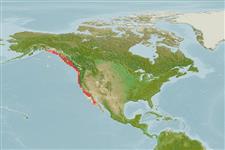Environment: milieu / climate zone / depth range / distribution range
Ecology
Marine; demersal; depth range 9 - 547 m (Ref. 27437), usually 183 - ? m (Ref. 6885). Subtropical; 61°N - 27°N, 145°W - 113°W
Eastern Pacific: Yakutat Bay, Alaska to Rompiente Point, Baja California, Mexico.
Length at first maturity / Size / Weight / Age
Maturity: Lm 17.0, range 17 - ? cm
Max length : 38.0 cm TL male/unsexed; (Ref. 5483); max. reported age: 38 years (Ref. 39277)
Short description
Identification keys | Morphology | Morphometrics
Dorsal spines (total): 13; Dorsal soft rays (total): 12 - 14; Anal spines: 3; Anal soft rays: 5 - 8. Head spines strong to moderate - nasal, preocular, postocular, tympanic and parietal spines present, nuchals usually absent, supraocular and coronal spines absent (Ref. 27437). Eye large; 2 strong, sharp, hooked spines on lower margin of suborbital bone; 2nd anal fin spine longer than 3rd in depressed fin (Ref. 27437). Caudal fin moderately indented (Ref. 6885). Pinkish red to yellowish red, silvery ventrally; dusky saddles on back, may be vague; green streaks on caudal fin (Ref. 27437).
Mostly found in offshore water on soft bottoms (Ref. 2850). Ovoviviparous (Ref. 6885). Anterolateral glandular grooves with venom gland (Ref. 57406). Commonly caught with trawls but usually discarded because of its small size (Ref. 2850). Rarely taken on baited hook in deep water (Ref. 2850).
Ovoviviparous (Ref. 6885).
Eschmeyer, W.N., E.S. Herald and H. Hammann, 1983. A field guide to Pacific coast fishes of North America. Boston (MA, USA): Houghton Mifflin Company. xii+336 p. (Ref. 2850)
IUCN Red List Status (Ref. 130435: Version 2024-2)
Human uses
Fisheries: commercial; gamefish: yes
Tools
Special reports
Download XML
Internet sources
Estimates based on models
Preferred temperature (Ref.
123201): 5.9 - 8.3, mean 6.5 °C (based on 19 cells).
Phylogenetic diversity index (Ref.
82804): PD
50 = 0.5000 [Uniqueness, from 0.5 = low to 2.0 = high].
Bayesian length-weight: a=0.01000 (0.00495 - 0.02022), b=3.09 (2.92 - 3.26), in cm total length, based on LWR estimates for this Genus-body shape (Ref.
93245).
Trophic level (Ref.
69278): 3.7 ±0.5 se; based on size and trophs of closest relatives
Resilience (Ref.
120179): Low, minimum population doubling time 4.5 - 14 years (K=0.06; tm=4; tmax=38; Fec=15,000).
Fishing Vulnerability (Ref.
59153): Low to moderate vulnerability (28 of 100).
